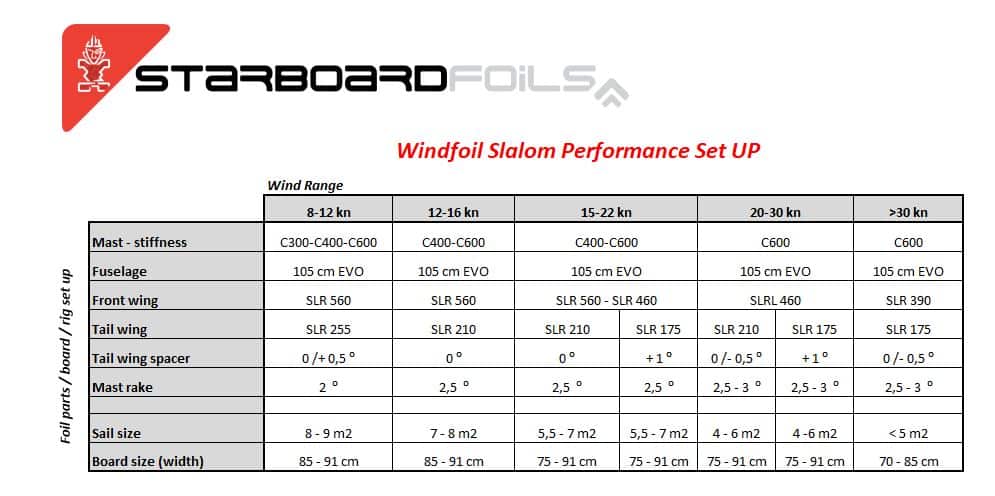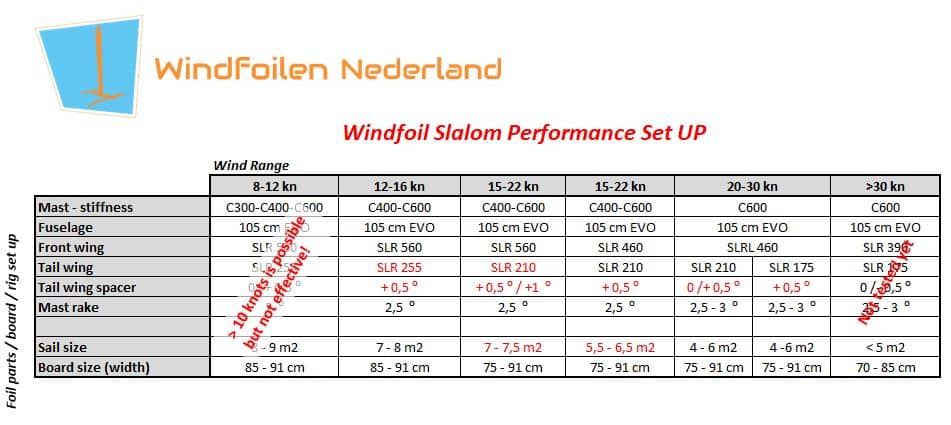The line up of Starboard foils with wings, masts and fuselages is very extensive but missed a series of high end slalom front and back wings. At the beginning of 2022, Starboard introduced the SLR series of front wings and back wings. Finally, the first shipments of SLRs have been delivered. Time to test them out. Since it is now summer in the Netherlands, it is necessary to look for the right conditions. That is why we are constantly updating and adjusting this review.
Update 4: 8/15/2022 – SLR 460 front wing / 175 back wing
How to test?
We know all too well that if you are going to test or tune material, it is important to adjust only 1 variable each time and also compare it directly with the old setting or the reference material. Because the SLR front wings and SLR back wings differ in all areas compared to the now well-known Starboard front and back wings, we work step by step. Let’s talk about us. We weigh around 80 kg, with a more than average pumping technique and a lot of racing experience on the wind foil. We use the IQfoil men set up (IQfoil carbon 95, IQfoil carbon carbon and HGO 9.0m2) and the Starboard Foil Slalom 81 with the Severne Hyper Glide 5 in sizes 7.0m2 and 6.0m2.
The specs of the Starboard SLR wings in outline
- Front wing: the aspect ratio (wingspan / width) of the 575 EVO = 5.1 and that of the SLR 560 = 7.0
- Back wing: the aspect ratio of the 255-2 = 5.1 and that of the SLR 255 = 7.3
- The SLR wings are between 10% and 30% thinner than the EVO wings (depending on where you measure)
- Due to the larger aspect ratio, the curve is slightly rounder at the SLR wings, which may indicate a relatively high lift
Starboard SLR back wing 255 in light weather with race set up
We start with the Starboard SLR back wing 255. There is little wind, about 8 to a maximum of 12 to 13 knots and we foil with the IQfoil senior set up. In these conditions we always sail the IQfoil with a back wing spacer of + 0.5m2 and the standard mast rake of +/- 1.5 degrees. We replace the standard 255 -2 back wing (so no thin!) for the SLR back wing 255. We get away just as easily as with the standard 255 -2 back wing, but we immediately notice upwind that the lift is slightly less than standard 255 -2. But not much difference. Certainly in fits and starts we have the strong impression that the final speed upwind is higher. If we then go half wind and down wind then we are more controlled than with the 255-2 and we go faster. It even seems that the higher the speed, the less lift the back wing gives. This makes it easier to keep control of the set at high speeds. It is strange to notice that we lift almost as much in the lower wind range as with the standard back wing, so that we also stay in the dips in the air. The feeling we have while flying is confirmed on the GPS after the session. The upwind speed was not higher, but the half wind and downwind speed was over 3 km/h faster (with similar conditions and setup) than with the standard 255 -2! In addition, we had the impression that the SLR provided better stability and balance. It felt very forgiving and gave confidence.
It pleasantly surprised us how well the SLR 255 fits into the light weather race setup. Only in the up wind we are slightly short of lift below +/- 10 knots so we could push just a little less high on the wind, but above that and certainly half and wide wind the SLR is better than the back wing 255-2.
Then also the comparison with the Starboard back wing 255-2 thin. We tried these several times in both the slalom set up and the race set up, but each time we felt that we had too little lift. This made the set quite nervous and the board was pressed on the water much faster with the tip of the board in a gust of wind. We also pulled the under part of the sail over the deck every time (and stuck behind the rear foot strap). The set sufficiently unbalanced. The SLR 255 gives clearly more lift compared to the 255 -2 thin!
Starboard SLR front wing 560 with back wing 255 in slalom set up
In somewhat challenging conditions with choppy waves up to about 3/4 meters we will test the ‘light wind set up’ with the Starboard Foil slalom 81 and the Severne HG4 7.0m2. The foilset up we use for this: IQfoil C400 carbon mast, 105 cm Evo fuselage, SLR front wing 560 and SLR back wing 255 with the + 0.5 degree spacer. Rake of the mast +/- 1.5 degrees.
The wind is in the beginning about 12 to 16 knots. On the side the wind is about 10 to 12 knots and with the 7.0m2 we notice that we clearly have to make more speed to get (and stay) in the air than with the Starboard EVO 575 front wing. Initially, we ‘fall’ back into the water a number of times. Only when we have really good pressure to make enough speed, we remain stable in the air. Once up to speed, the foil set up is remarkably stable and feels very well balanced. Where with the EVO front wing 575 we sometimes have the feeling that the foil does not want to go faster, we absolutely do not have that feeling now. The blades glide through the water with much less resistance.
Even with the first jibes we notice that SLR wings lose lift faster. At first we really struggled to stay in the air when the jibe came out. With the EVO 575 front wing, this is done with less effort. Over time, we did get the hang of it again, simply by jibing with more speed and conviction. During the session, our average speed also went up more and more.
As written, the conditions were quite tough, but on the sparse flatter parts, we could and dared to run the set. And then we really notice that there is a lot of potential in these wings (which we do not yet get out of it). The acceleration is phenomenal and also the control despite the choppy waves was better than with the EVO 575 front wing.
Starboard SLR 560 with 255 no light weather set up! [Update 20-6-22]
Starboard indicates that the SLR setup with the front wing 560 and back wing 255 can already be used between 8 and 12 knots with an 8 or 9 meters. But given the fact that your ‘initial speed’ really has to be considerably higher to stay in the air at all and also the necessarily higher speed that is needed to stay in the air during hijacking, it does not seem likely to us that this set up can really be used effectively under the 12 knots of wind. Also the PWA hot shot like Jordy Vonk, slalom foils with little wind also with bigger front wings!!
We sail the SLR 560 with the 255 on the IQfoil 95 with the HGO 8.0m2 in light weather conditions of around 9 to about 14 knots of wind. In the lower wind range we do get into plane with many pumps, but as soon as we pop the board up, the board immediately falls back. Only when we get a good flurry of more than 10 knots, we have enough speed and lift to stay in the air. Up to about 12 knots of wind we also have the continuous feeling with this set up we actually have too little lift to really go fast. We also drop back every time with the jibing. Only around 12 knots of wind do we keep enough speed to get out of the jibe foiling. We swap the SLR 560 for the 650 EVO and immediately it is clearer that it gives more lift and also stays in the air longer in wind dips. Also, the jibing is clearly easier and we are ultimately also faster on the reaches
For us it is clear that the SLR 560 under 12 knots of wind is not really effective. You may be able to fly, but with larger front wings you are guaranteed to be faster!
Starboard SLR 560 with SLR 210 medium wind set up [Update 21-7-22 | Update 2-8-22 (+ 1 spacer)]
We also foiled the SLR combi 560 with SLR 210 back wing in the wind range of 12 to 16 knots with the Severne Hyperglide 5 7.0m2. We use the + 0.5 degree spacer again. Only from about 13 to 14 knots do we really get away with this set up, but then we still have the feeling that we actually have too little lift. We have to tilt the sail all the way back to keep enough lift. The underbody rests completely on deck, which is therefore not pleasantly foiled. From about 16 knots we notice that the set-up with the SLR 210 starts to become really effective. If the wind picks up even further to about 20 knots, then all the brakes really come off. The set up feels very stable and the lift is also easy to control. Despite the smaller back wing, the foiling is still the same as described above.
Update (+1 degree spacer): The use of the +1 degree spacer from about 15 knots with the 210 SLR back wing clearly gives more power in the sail and more lift. Despite the fact that we have the idea that we have a little more resistance, we are still faster with this set up. In addition, we no longer have any problems with the lower body sticking behind the rear footband.
Up to about 20 knots, we also do not have the idea that a smaller front wing is needed or will be more effective. From about 20 knots of wind strength we would rather take a sail size smaller since the Severne Hyperglide 5 7.0m2 is now starting to be very large for us. So here too, Starboard is too optimistic about the range of deployment of the SLR wings (see also our updated schedule below).
Starboard SLR 460 with 210 back wing
Finally we have the day with enough wind to try out the smaller SLR front wings. We start with the set up as described above. The wind is between 16 and 22 knots and we sail again with the Hyperglide 5 7.0m2. In the fits and starts, we are overpowered. Time to put the SLR 460 on it. We keep the + 1 degree spacer on the SLR 210 back wing and the wind remains gusty. What is striking is that the SLR 460 comes up not much later and that the set also feels perfectly stable in the air. However, we immediately feel that this wing is a lot faster. The 1st hostage that we also use with a strong speed goes well, we stay in the air! Under the approx. 15-16 knots, the SLR 460 is really too small. We stay in the air, but we lose a lot of speed. After we are really used to the SLR 460, we notice that set up with our weight (about 80 kg) is more relaxed and effective than with the SLR 560 (which gives a little too much lift for us with a bit more wind). So that we can stand and hang even more in balance, without having to hang too much forward.
Starboard SLR 460 with 210 back wing & HG5 6,0m2
Now that we are busy and there is a good wind, we take a size smaller and we take the HG5 6.0m2. The wind still varies between 16 and 22 knots. What we immediately notice is that with the 6.0m2 the foil gives much more lift than with the 7.0m2. In other words, the HG5 7.0m2 delivers much more down force than the HG5 6.0m2. We reassemble the + 0.5 degree spacer instead of 1 degree spacer. The set feels very stable again. What a fantastic set up. Even if the wind decreases slightly, we continue to keep sufficient speed. If there is another flurry, you feel an absurd acceleration.
Starboard SLR 460 with 175 back wing & HG5 6,0m2 [update 15-8]
Finally good constant conditions to test the SLR 460 with 175 back wing. The wind varies between 18 and 24 knots. We foil ‘well powered’ with the Severne HG5 6,0m2. We switch the SLR 210 back wing for the SLR 175 and change the spacer from +0.5 to +1 (as recommended by Starboard). We go on the water and actually in the first rak it becomes clear that the SLR 175 with + 1 spacer gives too much lift. The lift is similar to the SLR 210 in these conditions. We change the spacer again for the + 0.5 degree and that seems to be the right choice. The set up still provides enough lift although we (of course) give up some stability. We are amazed again how (relatively) easy we get into the air. We don’t experience much difference with coming up compared to the SLR 210. What we do notice is that the combination with SLR 460 and SLR 175 is also a lot faster. The acceleration is phenomenal. When we steer the set down wind, the acceleration is huge with still good control. With our set up we think that the tipping point from the SLR 210 to the SLR 175 is around 20-22 knots.
Starboard SLR 460 vs SLR 560, when which one?
In a fairly similar wind range (between 16 and 20 knots) the SLR 460 and SLR 560 with the SLR 210 both work very well. When should you choose which set up in this wind range?
- SLR 460 with smaller sails 7,0m2
- SLR 460 if you weigh max 80-82 and SLR 560 if you are > 85 kg
- SLR 560 if there are a lot of wind dips and you foil a lot of short rakes (so a lot has to be hijacked)
- SLR 460 for that one flurry to reach maximum speed 😉
General learnings tuning SLR Slalom set up [update 15-8]
- Don’t grab a smaller back wing too quickly. More lift also gives more power in the sail, so you can accelerate ample wind even more (despite the larger surface area of the wing)
- A spacer with a larger angle also provides more lift. This gives a similar effect as described above
- We have found out about other slalom foil boards that the Starboard Foil Slalom 81 gives a relatively large lift, so the fine tuning of the foil depends on board
- Each (foil) sail (even differs per size) gives a different amount of down force. So per sail size it is often necessary to adjust the trim of your foil.
Starboard advice setup SLR wings for slalom vs experience Windfoilen Netherlands set up
Below left the table of Starboard with the advice set up of the SLR wings. On the right side the set up as we recommend it o.b.v. our findings. Our overview is therefore work in progress (oh how annoying we have to do this ;))




